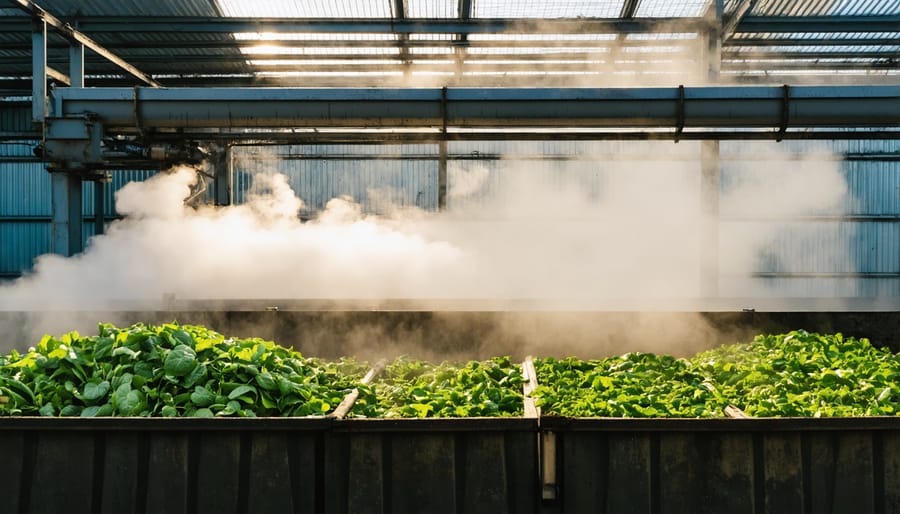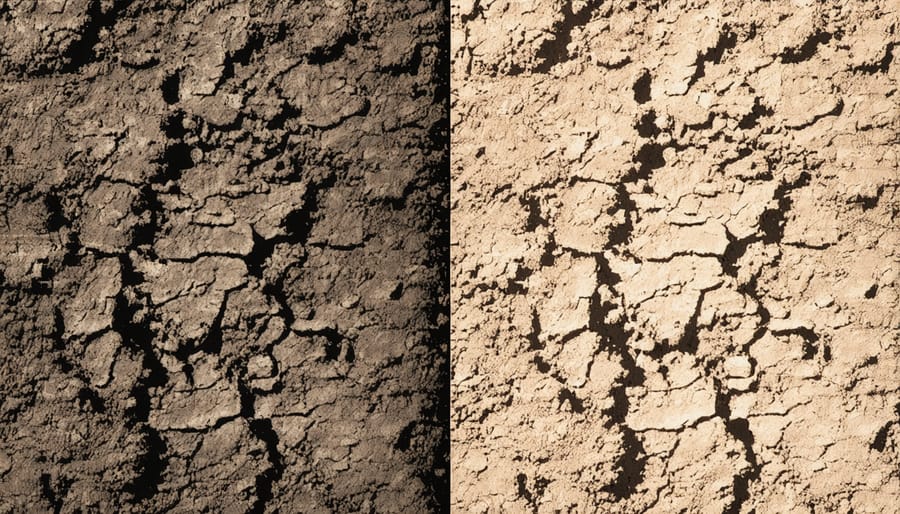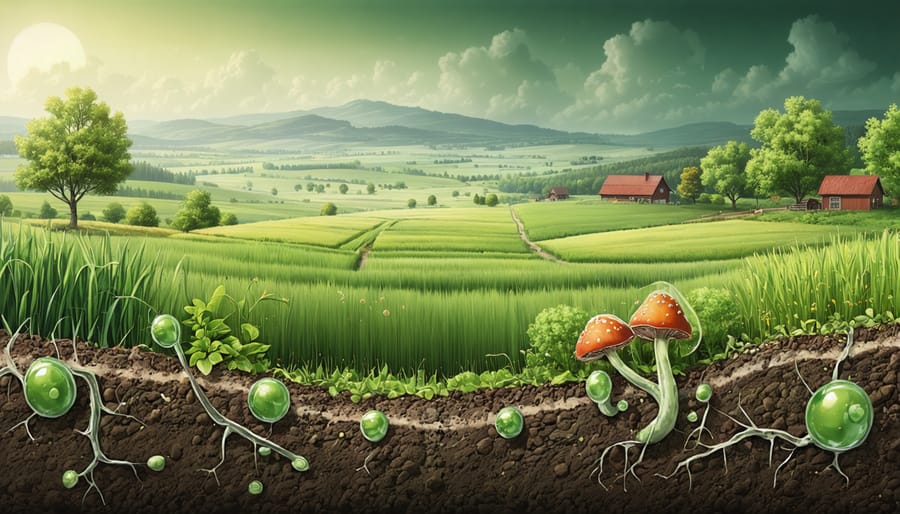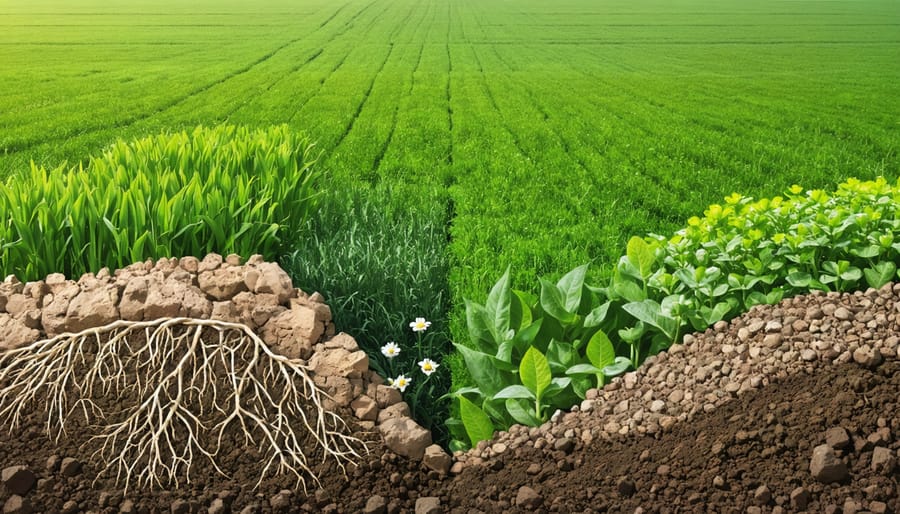Microbiological methods revolutionize agricultural waste management by harnessing nature’s most efficient decomposers: bacteria and fungi. These microscopic powerhouses transform farm waste into valuable resources, reducing environmental impact while boosting soil productivity across Canadian farmlands. In Alberta alone, innovative microbial techniques help farmers convert over 2 million tonnes of agricultural waste annually into nutrient-rich soil amendments.
From composting dairy waste to managing crop residues, microbiological approaches offer practical, cost-effective solutions that work with our unique Canadian climate. These methods not only accelerate decomposition rates by up to 60% compared to traditional practices but also significantly reduce greenhouse gas emissions and odor concerns that often challenge farm communities.
Whether you’re operating a small family farm or managing large-scale agricultural operations, understanding and implementing proper microbiological techniques is crucial for sustainable waste management. Modern agricultural success increasingly depends on these microscopic allies, which help maintain soil health, reduce chemical inputs, and create closed-loop farming systems that benefit both the environment and the bottom line.
This comprehensive guide explores proven microbiological methods tailored specifically for Canadian agricultural conditions, combining traditional knowledge with cutting-edge research from Alberta’s leading agricultural institutions.
Nature’s Clean-Up Crew: Understanding Microbial Decomposers

Key Bacterial Species in Agricultural Waste Management
Several bacterial species have proven particularly effective in managing agricultural waste across Alberta’s diverse farming operations. Bacillus subtilis and Lactobacillus plantarum are workhorses in composting systems, breaking down complex organic materials into nutrient-rich soil amendments. These bacteria thrive in our climate and can remain active even during cooler periods.
Local success stories, like the Watson family farm near Red Deer, demonstrate how Pseudomonas putida effectively reduces odours in manure management while accelerating decomposition. Similarly, Rhodopseudomonas palustris has shown impressive results in treating liquid waste from dairy operations, particularly in closed-loop systems.
For crop residue management, Cellulomanas fimi and Streptomyces species excel at breaking down tough plant materials like wheat straw and corn stalks. These bacteria are naturally present in healthy soil and can be enhanced through proper moisture and temperature management.
Remember, maintaining the right conditions for these beneficial bacteria is key. Our experience shows that keeping moisture levels between 40-60% and temperatures around 15-25°C creates an ideal environment for these hardworking microorganisms.
Fungal Powerhouses for Organic Matter Breakdown
In Alberta’s diverse agricultural landscape, beneficial fungi serve as nature’s master decomposers, breaking down tough organic materials that other microorganisms struggle to process. These remarkable organisms use specialized enzymes to transform crop residues, wood chips, and even stubborn lignin compounds into valuable soil nutrients.
What makes fungi particularly effective is their unique hyphal network – thread-like structures that extend throughout organic matter, releasing powerful decomposition enzymes. Many Alberta farmers have discovered that fungi like white-rot species can reduce thick corn stalks and wheat straw to rich, dark compost in just a few months.
Local success stories include the Morgan Valley Farm near Red Deer, where implementing fungal-based composting reduced their organic waste by 60% while producing premium soil amendments. Their secret? Maintaining optimal moisture levels around 50-60% and ensuring good aeration through regular turning.
The best part is that these beneficial fungi already exist in your soil – they just need the right conditions to thrive. Simple practices like maintaining proper moisture, avoiding excessive tillage, and incorporating diverse organic materials can help build a robust fungal network on your farm.
Practical Applications on Alberta Farms
Composting with Microbial Accelerators
Enhancing your composting process with microbial accelerators can significantly reduce decomposition time while improving the quality of your final product. Building on proven composting systems, here’s how to effectively incorporate beneficial microbes into your process.
Start by selecting a high-quality microbial accelerator suitable for Alberta’s climate. Layer your organic materials as usual, maintaining a proper carbon-to-nitrogen ratio of 30:1. For every cubic metre of compost, mix 1-2 kg of microbial accelerator with 10 litres of non-chlorinated water.
Apply the solution evenly across each layer as you build your pile. Maintain moisture levels between 50-60% – material should feel like a wrung-out sponge. Monitor temperature daily; optimal range is 55-65°C. Turn the pile when temperature exceeds 65°C or drops below 55°C.
Many Alberta farmers report seeing finished compost in 6-8 weeks using this method, compared to 3-4 months without accelerators. Keep detailed records of temperature, moisture, and turning schedule to refine your process over time.
Remember to protect your pile from extreme weather conditions with proper coverage, especially during prairie winters. This helps maintain consistent microbial activity and ensures optimal decomposition rates year-round.

Livestock Waste Treatment Solutions
Modern livestock operations can effectively transform farm waste into value through innovative microbiological treatment methods. Here in Alberta, farmers are increasingly adopting anaerobic digestion systems, which use specialized bacteria to break down manure and organic waste into biogas and nutrient-rich fertilizer.
One particularly successful approach combines thermophilic bacteria with traditional composting methods. These heat-loving microorganisms accelerate waste decomposition while eliminating harmful pathogens. Local farmer Mike Thompson from Red Deer County reports a 40% reduction in waste volume using this method, plus significant improvements in soil health when applying the treated material to his fields.
Beneficial microorganisms like Lactobacillus and Saccharomyces are being used in deep litter systems, helping to control odours and reduce ammonia emissions by up to 50%. These naturally occurring bacteria can be easily cultivated on-farm, making them a cost-effective solution for smaller operations.
For larger dairy and beef operations, automated bioreactor systems are gaining popularity. These systems use carefully selected bacterial cultures to process liquid manure, reducing environmental impact while creating valuable by-products. The treated effluent meets environmental standards and can be safely used for irrigation or returned to waterways, addressing both waste management and water conservation needs.
Crop Residue Management Techniques
Here in Alberta, managing crop residue effectively is crucial for soil health and future crop success. Local farmers have found that incorporating microbiological methods into residue management can speed up decomposition and enhance soil fertility naturally.
One effective technique is to inoculate crop residue with beneficial microorganisms right after harvest. Many Alberta farmers spray a mixture of specialized bacterial and fungal solutions onto stubble while it’s still standing. This kickstarts the breakdown process before winter sets in.
Proper moisture management plays a vital role in microbial activity. For best results, maintain residue moisture levels between 40-60%. During our dry prairie conditions, some farmers use light irrigation or time their microbial applications just before expected rainfall to optimize decomposition.
Strategic residue sizing also matters. Chopping residue into 10-15 cm pieces provides ideal surface area for microbial colonization while maintaining enough structure to prevent soil erosion during our strong winter winds.
Chad Peterson, a third-generation farmer near Red Deer, shares: “Since implementing microbiological residue management, we’ve seen faster breakdown of tough canola stems and better nutrient cycling. Our spring seeding is easier too.”
Remember to monitor soil temperature – microbes work best when soil temperatures are above 10°C. Consider this when timing your applications in our shorter growing season.
This approach not only speeds up residue decomposition but also builds long-term soil health while reducing the need for synthetic inputs.
Environmental Benefits and Soil Health Impact
Reducing Carbon Footprint
Microbial processes offer powerful solutions for reducing greenhouse gas emissions in agriculture, particularly through innovative carbon cycle farming practices. Here in Alberta, farmers are discovering that beneficial soil microorganisms can significantly decrease their carbon footprint while improving soil health.
These microscopic allies work tirelessly to sequester carbon in the soil through various processes. When we maintain healthy microbial populations, they help store carbon in stable forms that can remain in the soil for decades. For example, mycorrhizal fungi create glomalin, a sticky protein compound that both stores carbon and improves soil structure.
Many Alberta farmers have reported success with microbial carbon management strategies. By implementing cover crops and reducing tillage, they’re creating ideal conditions for microorganisms to thrive and store more carbon. Some operations have measured up to 2 tonnes per hectare of additional carbon sequestration annually through these methods.
Simple practices like composting with beneficial microbes can transform farm waste into valuable carbon-storing amendments. Adding bacterial inoculants to compost piles speeds up decomposition while capturing methane that would otherwise escape into the atmosphere. This process not only reduces greenhouse gas emissions but also creates nutrient-rich soil amendments that further enhance carbon storage capacity.
Remember, every farm’s microbial ecosystem is unique, so start with small trials to find what works best for your operation. Local agricultural extension services can help you monitor soil carbon levels and adjust your management practices accordingly.
Building Better Soil Structure
Building soil structure through microbiological methods is a long-term investment that pays dividends for generations to come. When farmers in Alberta implement these practices, they create a foundation for sustainable agriculture that benefits both their immediate yields and future farming operations.
Microorganisms play a crucial role in developing stable soil aggregates, which are essential to improve soil health and productivity. These tiny workers create natural glues and networks that bind soil particles together, forming channels for water, air, and root growth.
Local success stories, like the Mackenzie family farm near Red Deer, demonstrate how implementing microbiological methods over five years led to significant improvements in soil structure. Their clay-heavy soil transformed from compacted and difficult to work with into a crumbly, well-structured medium that retains moisture effectively.
Key benefits of enhanced soil structure include:
– Better water infiltration and retention
– Reduced erosion risk
– Improved nutrient cycling
– Enhanced root development
– Greater resilience during drought conditions
For optimal results, maintain consistent soil moisture levels between 40-60% and minimize tillage operations. This creates an ideal environment for beneficial microorganisms to thrive and contribute to soil structure development. Regular soil testing and monitoring will help track progress and adjust practices as needed.

Getting Started with Microbial Solutions
Essential Equipment and Materials
To successfully implement microbiological methods on your farm, you’ll need a few essential tools and materials. Start with basic sampling equipment including sterile containers, soil probes, and temperature gauges. These help monitor soil conditions and collect samples for testing.
A reliable pH meter is crucial for measuring soil acidity levels, while moisture meters help track water content. Consider investing in a basic microscope (40x-100x magnification) to observe microbial activity, though this isn’t mandatory for day-to-day operations.
For storing and applying microbial solutions, you’ll need clean spray equipment, mixing tanks, and proper storage containers. Many Alberta farmers find success using backpack sprayers for smaller applications and tractor-mounted sprayers for larger areas.
Safety equipment is essential – rubber gloves, dust masks, and eye protection should always be on hand. Don’t forget record-keeping materials to track applications and results.
Most materials can be sourced from local agricultural suppliers, and many extension offices offer equipment lending programs. Remember, you don’t need to invest in everything at once – start with the basics and expand as needed.
Local Support and Resources
Alberta farmers have access to numerous local resources and expert assistance for implementing microbiological methods in their agricultural practices. The Alberta Agriculture and Forestry department offers dedicated support through their network of field specialists who can provide on-site consultations and technical guidance.
Farmers can connect with agricultural research facilities like the Lethbridge Research and Development Centre, which specializes in sustainable farming practices and soil health management. The University of Alberta’s Faculty of Agricultural, Life & Environmental Sciences also provides valuable research support and testing services for soil and water samples.
For hands-on assistance, the Agricultural Research and Extension Council of Alberta (ARECA) operates through various applied research associations across the province. These organizations regularly host workshops, field days, and training sessions focused on microbiological methods and soil health improvement.
Local agricultural societies and producer groups often organize peer-learning opportunities where farmers can share experiences and best practices. The Alberta Farm Fresh Producers Association maintains a network of farmers practicing sustainable methods and offers mentorship opportunities for those new to microbiological farming techniques.
Implementing microbiological methods on your farm is a significant step toward sustainable agriculture and improved soil health. Throughout Alberta, farmers who have adopted these practices report enhanced crop yields, reduced input costs, and more resilient soil systems. By understanding and applying these methods, you’re not just improving your farm’s productivity – you’re contributing to a more sustainable future for Canadian agriculture.
Remember that success with microbiological methods comes from consistent application and careful monitoring. Start small, perhaps with a test plot, and gradually expand as you become more comfortable with the techniques. Connect with local agricultural extension services and fellow farmers who have experience with these methods. The Alberta farming community is known for its collaborative spirit, and there’s tremendous value in sharing experiences and lessons learned.
The investment in microbiological methods – both in time and resources – pays dividends through improved soil structure, enhanced nutrient cycling, and reduced dependence on synthetic inputs. As climate challenges continue to affect our farming practices, these biological approaches offer a proven way to build resilience into your agricultural system.
Take the next step by selecting one or two methods that align with your farm’s needs and start implementing them this growing season. The future of sustainable Canadian agriculture begins with the choices we make today on our farms.









